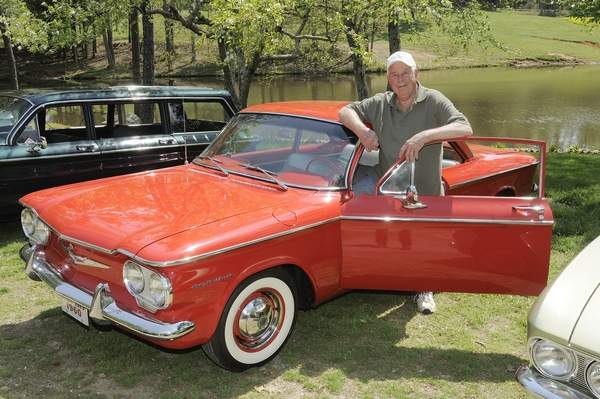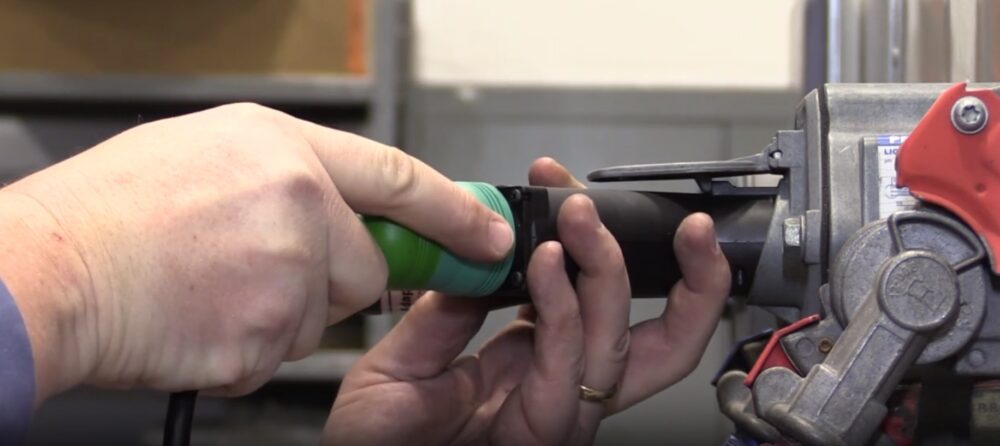The Chevrolet Corvair is celebrating its 50th birthday this year, and Willard Moody of Lexington, NC, has been collecting the vehicles since he bought his first one in 1965 for $400.
Below is the article as it appeared on The Dispatch website.
Retired educator turns cars into hobby
BY STEVE HUFFMAN
The Dispatch
Published: Thursday, April 15, 2010 at 4:47 p.m.
Last Modified: Thursday, April 15, 2010 at 4:47 p.m.
 Every so often, Willard Moody and his wife, Sharon, climb into one of their beloved Chevrolet Corvairs, fire the little sucker to life and take off up the road.
Every so often, Willard Moody and his wife, Sharon, climb into one of their beloved Chevrolet Corvairs, fire the little sucker to life and take off up the road.
Moody, 76, learned long ago that wherever he and his wife choose to stop, a conversation is sure to follow.
“Even adults, sometimes they don’t know what they are,” Moody said of the Corvair, a rear-engine ride that was produced from 1960 to 1969. “They’ll ask, ‘What is it?’ ‘Did it come from overseas?’”
The Corvair, a car that at the time of its introduction was considered cutting edge, is celebrating its 50th birthday this year. Quick! Somebody give this little guy his AARP card.
“I’ve always thought the Corvair was ahead of its time,” said Moody, a retired educator who spent his entire career with the Lexington City Schools, last working as principal at Southwest Elementary. “They were neat, little, simple vehicles. They’re still a lot of fun to own and drive.”
Moody, who along with his wife lives in a picturesque, 200-year-old cabin about a quarter-mile off Lamb Road in western Davidson County, bought his first Corvair in 1965 when he was teaching. The car was a 1961 model that Moody purchased from one of his fellow educators. He paid a whopping $400.
It didn’t happen overnight, but as the years progressed, Moody became hooked on the Corvair.
“It was just so darn tough,” he said. “It just kept running.”
Through the late-’60s and early-’70s, Moody collected more than 100 Corvairs. They were at the time aging vehicles with little monetary value. They weren’t considered collectibles, just old and odd. Often, people would call Moody and tell him he could have their car provided he pulled it from the yard.
Usually, Moody would happily oblige.
Most of the cars that Moody collected all those years ago are long gone. The majority weren’t worth a lot, Moody admitted, not good for much more than scrap metal.
Today, he owns about a dozen of the vehicles in varying states of restoration or disrepair, sheltered in barns and garages spread across his 31 acres. Some of the cars are pristine. Others are anything but.
Moody has a bright red Corvair from the first year of the car’s production (the license plate on the front of that 1960 model reads “Alpha”) and a green one that rolled off the assembly line just before General Motors pulled the plug on its production (fittingly, the license plate on that 1969 model is “Omega”).
Moody continues to work on Corvairs for himself and others as time allows and the mood strikes. A sign there in one of his garages reads, “Moody’s Corvair Center.”
Moody argues that the Corvair’s reputation for — how to phrase this politely? — “engineering quirks” was largely undeserved. Sure, the car leaked a bit of oil, but what vehicle of the era didn’t after a few years and miles, Moody counters?
Moody said the leaks were the result of rubber oil rings that hardened with age. Nowadays, when Moody rebuilds a Corvair motor, he uses oil rings made of Vitron, a more recent creation that doesn’t harden or turn brittle.
Voila! No more oil leaks.
Moody said Ralph Nader’s attacks on the Corvair were largely undeserved. In the mid-1960s, the consumer advocate attorney wrote a book titled “Unsafe At Any Speed.” In it, Nader charged that the Corvair was a risk to overturn, even when driven at low speeds. The problem with the car, the attorney said, stemmed from a swing-axle design found in the early models.
Nader also criticized the “cookie cutter” dashboards of the Corvair that were made of bare metal and little else. With no seat belts, a stomp on the brakes could send front-seat passengers sailing into the dashboard at a cost of a mouthful of teeth.
Moody said he’s driven his Corvairs hundreds of thousands of miles and has never experienced anything like the problem with rollovers that Nader described. As far as the car’s bare-metal dashes were concerned, Moody doesn’t argue the point, but notes that just about every car manufactured in the era featured a similar design.
Moody also points to a 1971 study by The National Highway Traffic Safety Administration that largely vindicated the Corvair, deciding the vehicle was as safe or safer than most of its competitors.
So take that, Ralph.
What played a major role in the Corvair’s undoing, Moody said, was that it was based on practicality. Sure, the six-cylinder beast got about 25 miles to a gallon of gas — a remarkable figure for the time. But even high-octane fuel was only selling for slightly more than 20 cents a gallon back then, so no one really cared about gas economy.
Heck, even the mention of scrimping at the gas pumps was considered uncool.
What Americans wanted, Moody said, were muscle cars, big brutes that rumbled when they rolled.
“Lots of my buddies say, ‘It wasn’t Nader who did in the Corvair, it was the Mustang,’” Moody said, referring to Ford’s pony car that was introduced in 1965 and proceeded to eclipse every automotive sales record there was.
Still, the Corvair should be considered anything but a flop. Moody noted that during the almost 10 years the vehicle was produced, Chevrolet churned out 1.8 million of the rides in every form from four-door sedans to convertibles, trucks and even vans.
“My experience with them has just been tremendous,” Moody said. “I can’t say enough about the vehicle.”
Student helps teacher
In the late 1960s, Barry Owen took a shop and drafting class under Moody at Lexington High School.
“He paddled my a — the first day,” Owen recalled of his teacher. “I deserved it. I was a smart-aleck.”
Today, Owen owns Owen Racing on Dixie Street near the Davidson County Airport. He builds race cars but also does a considerable amount of work on Corvairs, performing everything from tune-ups to total restorations. People bring their cars from all over the Southeast for Owen to repair.
Owen said he bought his first Corvair in 1967 when he was only 15, so he was already on his way to developing a love affair with the vehicles before he walked into that shop class at Lexington High. But he said his fondness for the Corvair may not have reached the level it did had it not been for Moody’s influence.
Owen said that while his classmates were spending their school days concentrating on shop tasks, Moody put him to work on more important endeavors.
“While everybody else was building little boxes or something, I’d be working on Willard’s Corvair,” Owen said.
Today, he’s still working on them. When Moody has a problem too tough for him to handle — an automatic transmission that needs to be rebuilt, for instance — he hauls the car to Owen.
Owen said he can’t help but grin when he looks up and sees Moody walking in the door seeking advice.
“Oh, yeah, he loves them cars,” Owen said.
Value is increasing
Moody said that when the Corvair was introduced, a new one could be purchased for about $2,200. Today, his red 1960 model, one of the finest of its type, might fetch between $18,000 and $22,000.
That’s if Moody wanted to sell. Which he doesn’t.
Moody said similar Corvairs can be had for much more reasonable prices. A good daily driver, he said, can still be purchased for about $3,000.
“They’re still one of the most affordable vehicles to restore,” Moody said. “Parts are readily available. They’re easy to work on. Just don’t buy one eaten up with rust.”
He also noted that, nowadays, the Corvair is on its way to being considered — dare we say it?! — cool. Jay Leno includes a couple of Corvairs in his vast array of collector vehicles. The Corvair, long a “sleeper” vehicle in that it could be had at a bargain price, is escalating in value.
Moody is past president of Classic Corvairs of the Triad, a club to which he still belongs. He’s also past president of the North Carolina branch of CORSA (Corvair Society of America) and a member of CORSA National.
Moody said he sees the worth of the cars doing nothing but continuing to climb. He said he occasionally runs into one of his former students who still remembers the little cars he used to drive back and forth to school.
“They still say, ‘There’s Mr. Moody, the Corvair man,’” Moody said, chuckling as he spoke. “It’s just been a fun hobby for me all these years.”
Corvair trivia (courtesy of Willard Moody)
• The first Corvair rolled off the assembly line in Willow Run, Mich., on July 7, 1959.
• The Corvair was introduced to the general public Oct. 2, 1959.
• At the beginning, all Corvairs were four-door models.
• Two-door coupes were introduced in January 1960.
• Approximately 250,000 Corvairs were sold in 1960.
• The cars were intended to battle the Volkswagen Beetle, which had begun to increase in popularity in the United States in the late 1950s.
• Station wagon versions of the Corvair were introduced in 1961 and continued through 1962.
• Corvair trucks — featuring Rampsides and Loadsides — were produced from 1961 to 1964.
• The second version of the Corvair was introduced in 1965. It was available in coupe, sedan and convertible models. This version resembled a Camaro.
To read this article on The Dispatch website, visit http://www.the-dispatch.com/article/20100415/ARTICLES/100419921?p=1&tc=pg.


